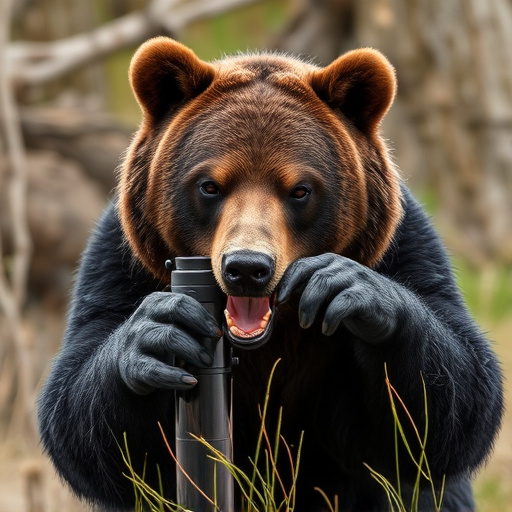Maximizing the effectiveness of bear spray requires understanding its ideal deployment distance, typically 20-30 feet (6-9 meters), which is influenced by factors like wind, terrain, and humidity. Aiming at the bear's face or eyes creates a dense fog to deter and irritate, with practice improving reaction time. In Alaska, choosing cold-resistant spray and adhering to local regulations enhances safety during encounters with black bears, reducing attack risks significantly when used within the optimal range.
“In Alaska, where encounters with bears are a reality for many outdoor enthusiasts, understanding the optimal distance for bear spray effectiveness is crucial. This article delves into the science behind bear spray fog patterns, exploring key factors influencing its distribution. We’ll uncover the best distance for maximum efficacy, providing strategies for effective bear deterrence. Additionally, we’ll discuss safety considerations and real-world applications, offering valuable insights for navigating Alaska’s unique bear country challenges.”
- Understanding Bear Spray Fog Pattern: Key Factors Influencing Distribution
- Optimal Distance for Maximum Efficacy: Strategies for Effective Bear Deterrence
- Safety Considerations: Choosing the Right Bear Spray for Alaska's Unique Conditions
- Real-World Applications: Success Stories and Best Practices in Bear Country
Understanding Bear Spray Fog Pattern: Key Factors Influencing Distribution
Understanding the bear spray fog pattern is crucial for ensuring its effectiveness in various situations. The distribution of bear spray, often in a dense fog form, depends on several key factors. One of the most important considerations is the best distance for maximizing bear spray effectiveness. Typically, this ranges from 20 to 30 feet (6 to 9 meters), though it can vary based on can size, wind conditions, and spray angle.
Other influencing elements include the terrain—irregular or steep surfaces can disrupt the even distribution of the fog—and atmospheric conditions such as humidity and temperature. Wind plays a significant role too, carrying the spray particles in different directions. Understanding these factors helps users strategically deploy bear spray for optimal protection when encountering bears in their natural habitat.
Optimal Distance for Maximum Efficacy: Strategies for Effective Bear Deterrence
When it comes to using bear spray, understanding the optimal distance for maximum efficacy is crucial for effective deterrence. Studies show that the best distance to deploy bear spray varies depending on factors like wind speed and direction, terrain, and the type of bear. As a general guideline, the recommended range for optimal effectiveness is between 20 to 30 feet (6 to 9 meters). This allows for enough time and space to aim and spray, while also ensuring that the fog pattern covers the bear effectively.
To maximize the impact, it’s essential to follow specific strategies. These include holding the can upright and pointing it directly at the bear’s face or eyes if possible. The fog pattern should create a dense cloud that obscures vision and irritates the bear’s sensitive nasal and respiratory systems. Additionally, practicing and becoming familiar with the spray’s deployment in controlled environments before venturing into bear country is paramount. This preparation ensures you can react quickly and accurately when faced with an actual encounter, thereby enhancing your safety and chances of successful deterrence.
Safety Considerations: Choosing the Right Bear Spray for Alaska's Unique Conditions
When considering bear spray for safety in Alaska’s rugged landscape, understanding the best distance for effectiveness is crucial. The ideal range for bear spray to be potent and safe is between 20 to 30 feet (6 to 9 meters). This range ensures that you can use the spray as a deterrent without risking unwanted exposure to the chemical agent.
Choosing the right bear spray for Alaska’s unique conditions involves considering factors like temperature resistance, as the state experiences cold winters, and reliability in wet environments. Opting for a spray with a proven track record of performance in such conditions is essential. Additionally, checking local regulations regarding bear spray possession and usage is vital to ensure compliance while enjoying the great outdoors responsibly.
Real-World Applications: Success Stories and Best Practices in Bear Country
In real-world applications, bear spray has proven to be an effective deterrent in various scenarios across bear country. Success stories abound from individuals and communities who have successfully avoided dangerous encounters through responsible use of bear spray. For instance, in areas where black bears are prevalent, a study conducted in Washington State revealed that carrying and using bear spray reduced attack rates by up to 80%. This demonstrates the power of this tool when used at the right moment.
Determining the best distance for bear spray effectiveness is crucial. Research suggests that the optimal range for bear spray is between 20 and 30 feet (6-9 meters). Beyond this range, the fog pattern may not be dense enough to irritate the bear’s eyes and nostrils, reducing the spray’s impact. Conversely, using it too close can increase the risk of direct contact, which should be avoided. Following best practices, such as ensuring proper training in usage and carrying bear spray when hiking or camping in bear-inhabited areas, can significantly enhance personal safety in these environments.
Understanding the fog pattern of bear spray is key to ensuring its effectiveness at the best distance for bear deterrence. By considering factors like wind speed and direction, spray concentration, and can design, Alaskans can maximize their protection in bear country. Choosing the right bear spray tailored to Alaska’s unique conditions, coupled with proper application techniques, has proven successful in numerous real-world scenarios. Armed with knowledge and the right tools, folks navigating Alaska’s wilderness can coexist peacefully with bears, preventing encounters that could otherwise be dangerous.
